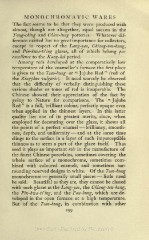Page 369 - Oriental Series Japan and China, Brinkly
P. 369
MONOCHROMATIC WARES
The fact seems to be that they were produced with
almost, though not altogether, equal success in the
Tung-ching and Chien-lung potteries. Whatever dif-
ference existed has no great importance for collectors,
except in respect of the Lang-yao, Chiang-tou-hung,
and Pin-kwa-ts' ing glazes, all of which belong par
excellence to the Kang-hsi period.
Among reds developed at the comparatively low
temperature of the enameller's furnace the first place
is given to the Tsao-hung or "
Jujube Red "
(red of
the Zizyphus vulgaris}. It need scarcely be observed
that the difficulty of verbally distinguishing these
various shades or tones of red is insuperable. The
Chinese showed their appreciation of the fact by
"
gRoeidng" to Nature for comparisons. The Jujube
is a
full, brilliant colour, perfectly opaque even
when applied in the thinnest layers. In this latter
quality lies one of its greatest merits, since, when
employed for decorating over the glaze, it shows all
the points of a perfect enamel brilliancy, smooth-
ness, depth, and uniformity and at the same time
clings to the surface in a layer of such imperceptible
thinness as to seem a part of the glaze itself. Thus
used it plays an important role in the manufacture of
the finest Chinese porcelains, sometimes covering the
whole surface of a monochrome, sometimes com-
bined with coloured enamels, and sometimes sur-
rounding reserved designs in white. Of the Tsao-hung
monochromes generally small pieces little need
be said. Beautiful as they are, they cannot be classed
with such glazes as the Lang-yao, the Chiang-tou-hung,
the 1 and the Fan-hung, which are de-
Pin-kwa-ts ing,
veloped in the open furnace at a high temperature.
But of the Tsao-hung, in combination with other
299

